Enosophia: First Wine with Interactive AR Label on Croatian Market
July the 5th, 2021 - Enosophia is the first wine available here on the Croatian market with an interactive AR label and an aim to properly position Slavonia among the top wine regions.
As Poslovni Dnevnik writes, Enosophia is the new face of the Croatian wine scene, a new brand from the Slavonian winery Feravino, which was presented to the public in the Zagreb restaurant La Grma. Enosophia, which in Greek means the wisdom of wine (from the words enos = wine and sophia = wisdom) is said to have originated as a result of development based on a long tradition, investment and ambition to create a quality wine story.
That is showcased by the fact that Enosophia, although a novelty here on the Croatian wine market, was developed as part of the natural process of growth and development of the Feravino brand.
"Through the new brand, we want to provide our consumers with added value, not only through raising the quality of our products but also through taking a holistic approach to the brand. It implies care for people, ecology and sustainable development as well as positioning Slavonia as a desirable wine tourism destination,'' they stated at the promotion of Enosophia.
“We're extremely happy to present Enosophia as a result of our winery's new development strategy and long-term sustainability. It includes significant investments in the development of the winery, the main goal of which is the development of Slavonia to be among the best wine destinations in Croatia. By caring for the sustainable development of the Fericanj area, we want to work on the return of young people to whom we can provide secure jobs and development prospects. We want to do this through and with our new brand Enosophia, which was developed by a team of dedicated and motivated people guided by a common vision,'' said Ivan Ergovic on behalf of the family.
Ivan Maricic, the director of the Osilovac company, added that Enosophia wants to be a modern winery based on the principles of sustainability and social responsibility, with innovative wines from the Fericanac vineyards.
“With the new Enosphia brand, we've gone through a demanding rebranding process guided by a clear vision that we want to be the best. And that in creating the best wine, we want the best teams, educated consumers and a better, more sustainable environment. Enosophia is a story we want to share because consumers today are looking for more than just products. They want a story, an emotion and an experience and that's exactly what makes Enosophia unique. We believe that our consumers will recognise the excellence, innovation and approach behind this wine story,'' stated the director of Osilovac.
A team of oenological experts, including Lucija Kuzir and Martin Kovacevic, is responsible for the development of the new Feravin brand.
The first two wines in the new "spirit" are Grasevina TRS No. 5 and the Matarouge rose, which is adorned with an interactive label with the features of AR (augmented reality), from which information about the wine and the producer can be read. According to the winery, it is the first of its kind in the Croatian wine industry, combining technology and wine in order to appeal to younger consumers.
According to the label, the Winery in Fericanci has had a cellar since back in 1804, and last year a new cellar was opened, which is a kind of synergy of tradition and modernity. Grapes in the Fericanci vineyards are grown on 160 hectares of vineyards and the presentation demonstrated how Enosophia goes with food, and the dishes that go well with these wines were designed by chef Goran Kocis, a holder of the Michelin star.
For more, follow our business section.
Srijem and Slavonia: A Taste of Happiness
April 3, 2021 - From small snacks to spicy dishes and the most delicate desserts, when it comes to food, Srijem and Slavonia are unsurpassed.
Slavonian small snacks and finger food are even tastier, for starters, if they are from the black Slavonian pig. Gingerbread, kulen, kulen cutlet, švargl, sausage, bacon, cheese, ajvar, and more. Then hearty soup, just removed from the heat, still smoked, then sarma and delicious cookies of all colors and sizes. First of all, brandy, and with every dish, the wine of the Srijem vineyards. A very ordinary day in Srijem and Slavonia will look like a real feast, so if you are a gourmet, be sure to stop by. The invitation is valid indefinitely.
It’s not that it won’t make your cheeks glow and your stomach warm. It has everything you need - a harmony of flavors: it is moderately salty, moderately thick, and somewhat spicy. The noodles melt in your mouth and red ground pepper does not cover the delicate taste of fish. It only lacks fish bones. That is why it was given an honest and straightforward name - boneless fish.
Vecernji List reports, this innovative version of one of the most popular dishes east of Zagreb was designed many years ago at the Dunav Hotel in Ilok and has since become their trademark. This hotel, otherwise a real avant-garde in the traditional Slavonian, Srijem, and Baranja cuisine, is not only known for its innovative fish, but it was also the first in this part of the country to receive a Michelin recommendation. Everyone who has eaten there at least once knows. Super price, top quality, everything is fine and fresh, and for a sweet finish, our recommendation is šnenokli. It may seem too simple to you, but that’s exactly where the charm lies. With an absolute explosion of flavors in such a traditional and everyday dish, you will want to immediately ask for a recipe from the head chef.
Good wines accompany delicate dishes, and those from Ilok, the center of the Srijem vineyards, have seduced the most demanding palates for centuries and are drunk in European courts since the princely family Odescalchi filled them in unique packages in the Old Cellars 200 years before Bordeaux and Burgundy. They are protected from traders and resellers who often confused it with that of inferior quality.
True connoisseurs and wine lovers in Ilok will enjoy the fragrant Traminers, and there is still talk of that Ilok cellars that were drunk at the coronation of Queen Elizabeth II. The grapes for the top Traminers of this most awarded Croatian winery are grown on Principovac, a famous wine-growing position and the country estate of the Odescalchi family, where his first vine was planted in 1710. Since then, this royal variety has not ceased to intrigue the wine world.
In Ilok, you have to walk through its beautiful historical core, visit the church of St. Ivana Kapistrana, the Museum of the City of Ilok in the Odescalchi Castle, the Old Cellars from the 15th and 18th centuries, and, with prior notice, at least two or three more wineries, about twenty of them on the Ilok Wine Road.
A homely, positive atmosphere, which can only be provided in Slavonia and a modern, refined interior, characteristic of fine dining restaurants in major world capitals, is how at first the new Vinkovci restaurant Lu could be described. The award-winning chef, Ana Marija Stanković, is a national champion and bronze medalist at the Culinary Olympics in Stuttgart. Fire burger, homemade smoked sausage, pork fillet, glazed pork ribs, chicken fillet in an almond crunch, french lamb rack, beefsteak, rump steak, perch fillet; you will enjoy its interpretation of traditional Slavonian cuisine; especially if you follow modern trends and above all appreciate quality food.

Restaurant Lu Vinkovci | Restraurant Lu Facebook
Although there are more and more modern restaurants and pubs, Srijem and Slavonia will wish you a warm welcome in traditional, proven good restaurants where dishes are simmered, long and slow, with a lot of heart and a few secret ingredients, just like the daughters-in-law used to do.
The final stop is Sotin, the popular Gondola restaurant, and the picnic area. It is cooked there according to traditional, carefully selected recipes. You will enjoy fragrant Slavonian sausages, the famous shepherd's pie or delicious Šokac steaks with špecli, and the greasy bread and the finest saltines homemade jam owned by Aunt Luca look so good and entice with the scents that even the most notable characters will not resist. And only when you take the first bite, that is the taste of happiness.
For more about lifestyle in Croatia, follow TCN's dedicated page.
Slatina Sparkling Wine Find Makes Slavonia Champagne Among Croatia's Oldest
February 13, 2021 – A newly discovered, fully preserved bottle of 'Slavonia champagne' is unique evidence that Slatina sparkling wine is among the oldest in Croatia. Its fascinating history stretches back over 150 years
A completely preserved Slatina sparkling wine bottle from the period from 1864 to 1912 has been discovered during building works of Slatina's new visitor's centre. Found at a depth of two metres, the bottle is physical proof of what was previously known only from records – this 'Slavonia champagne' is among the oldest sparkling wine to have been made in Croatia. © Robert Turkalj
© Robert Turkalj
The discovery of the Slatina sparkling wine bottle is important to the city and its history. Other regions in Croatia have become extremely well regarded over recent years for their production of quality sparkling wines. The production of Slatina sparkling wine briefly disappeared during a period. But, this bottle is evidence that Slatina sparkling wine was among the first to be made in the country. It is the only fully preserved bottle of the 'Slavonia champagne' to exist in the region.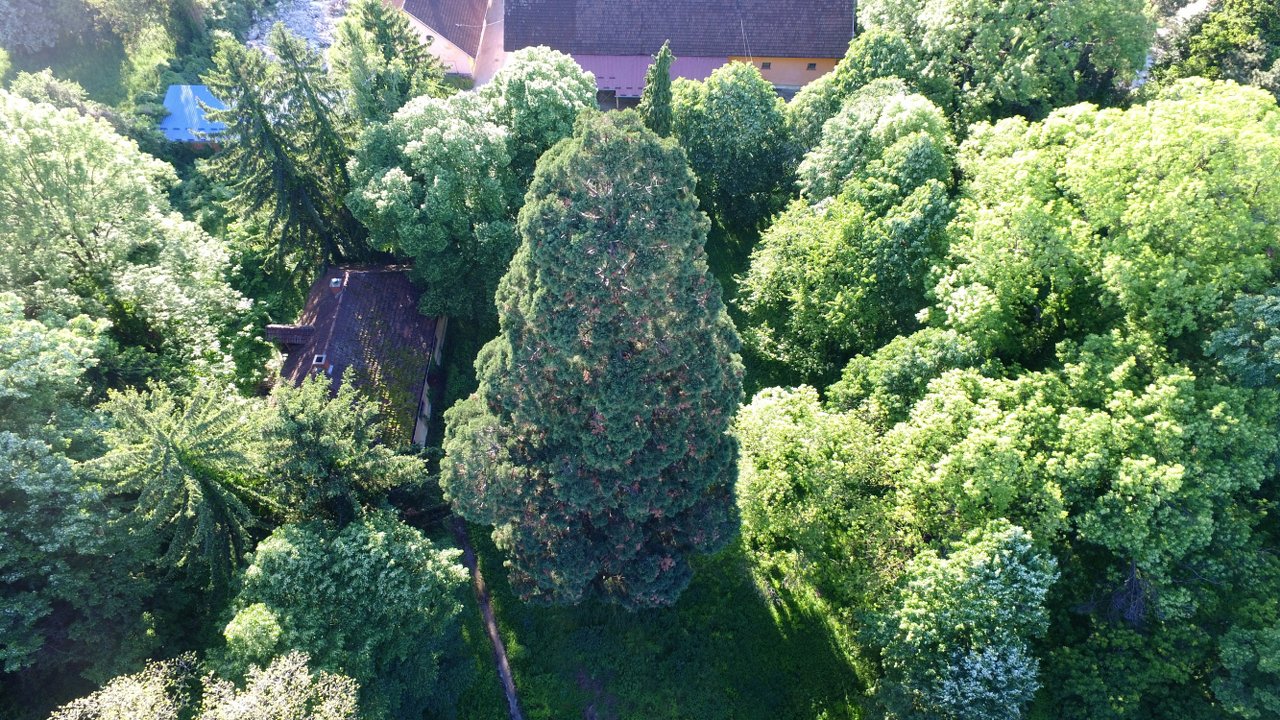 Slatina's nationally protected Giant Sequoia tree (Mamutovac) © Tourist Board of Slatina
Slatina's nationally protected Giant Sequoia tree (Mamutovac) © Tourist Board of Slatina
Of course, we can't really call it champagne – that title is reserved for a type of sparkling wine made in a distinct geographical region in France. But, there are great similarities between Slatina sparkling wine and champagne - similarities that do not exist exactly in other Croatian sparkling wines. Champagne is largely made from the Pinot Noir grape. The found bottle of Slatina sparkling wine was made from the Kadarka grape variety, which has been compared to Pinot Noir.
Both grape varieties are thin-skinned, delicate, easily susceptible to impairment and require a low yield to produce quality wines. Both are tricky to cultivate. For this reason, the Kadarka grape variety is now grown very rarely in Croatia, its place in vineyards taken by more hardy and some imported varietals. But, that wasn't always the case.
History of Slatina sparkling wine
In 1841, the German prince Georg Wilhelm Schaumburg-Lippe bought a property of land in the Slatina area from the Pejačević family. The land contained vineyards, orchards, agricultural fields and large forest areas, including the site of the new Slatina visitor centre where the bottle was discovered. Indeed, trees still line the road of Ulica kralj Zvonimir in the centre of Slatina – the cellar and restaurant of the town's famous Stari Podrum is just a few metres from Slatina's nationally protected Giant Sequoia tree (Mamutovac).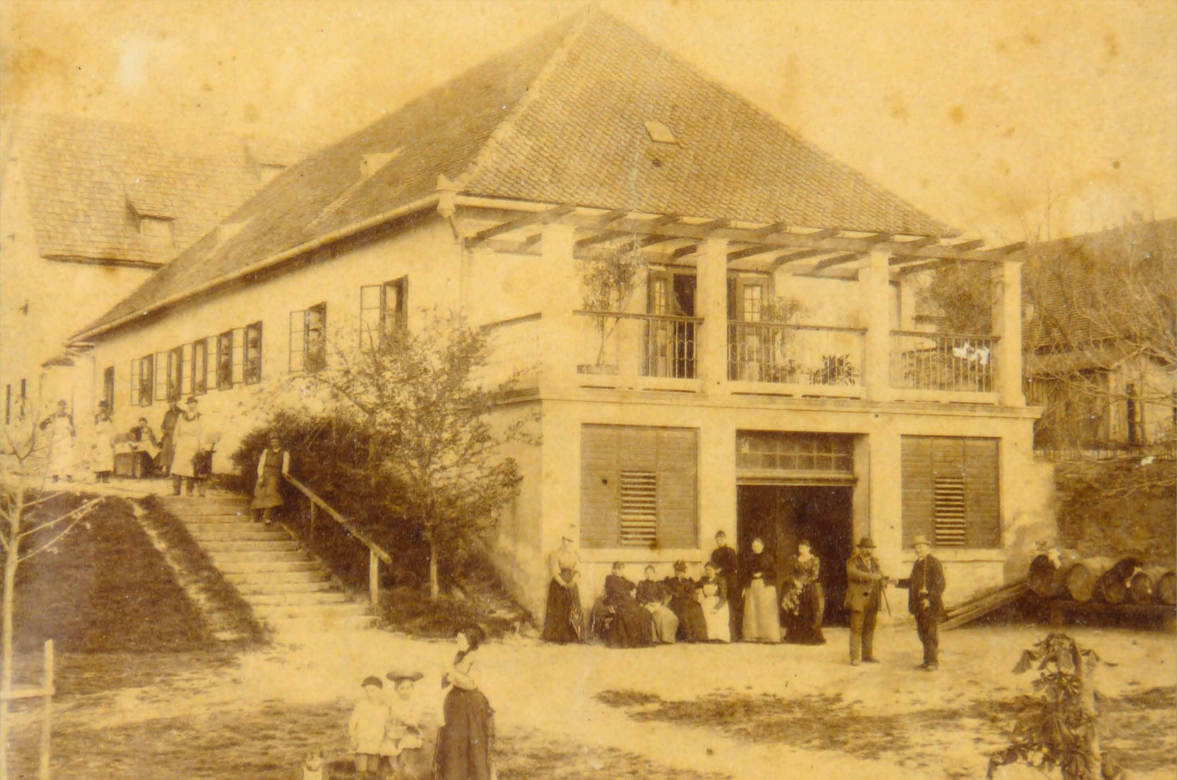 The Stari Podrum cellar, the site of the first-ever production of Croatian sparkling wine, at the beginning of the 20th century © Virovitica State Archives / Slatina Homeland Museum
The Stari Podrum cellar, the site of the first-ever production of Croatian sparkling wine, at the beginning of the 20th century © Virovitica State Archives / Slatina Homeland Museum
Slatina sparkling wine production started in 1864 at the Stari Podrum cellar, using the Kadarka grape variety. Perhaps it was the notorious difficulties of the growing the grape which resulted in slow initial progress for the production, but the enterprise got a massive boost in 1866 with the arrival of a new manager, Otto Rockhror. He rearranged the cellar and production, brought in new equipment and invested in marketing their Slatina sparkling wine. It worked.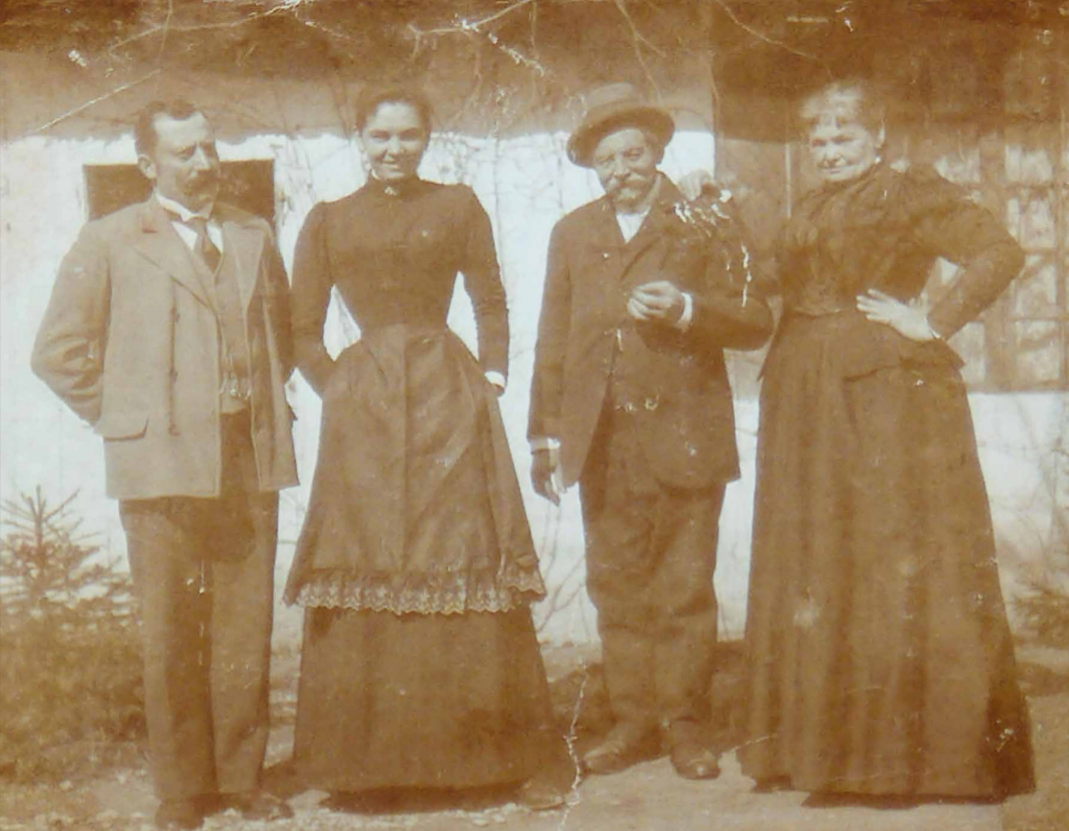 Left to right - Ljudevit Konstantinović, his wife Marija Konstantinović (the daughter of Otto Rockrohr), Otto Rockrohr and his wife Josefina Rockrohr © Virovitica State Archives / Slatina Homeland Museum
Left to right - Ljudevit Konstantinović, his wife Marija Konstantinović (the daughter of Otto Rockrohr), Otto Rockrohr and his wife Josefina Rockrohr © Virovitica State Archives / Slatina Homeland Museum
The quality of Slatina sparkling wine was recognized at the great Economic and Forestry Jubilee Exhibition in Zagreb in 1881 when Georg Wilhelm Schaumburg-Lippe received an honorary diploma and a large medal for domestic sparkling wine and fine wine. The credit perhaps lay elsewhere, considering it was the efforts of Otto Rockhror that were no doubt the cause, but, such were the times. However, Otto Rockhror's achievements with Slatina sparkling wine certainly did not go unnoticed.
At the Science and Industry Fair in Brussels, Belgium, in 1888, Otto Rockhror was awarded a bronze medal featuring the image of Leopold I. He received a further bronze medal with the image of Francis Joseph I in 1890 at the Agricultural and Forestry Exhibition in Vienna and was awarded a silver medal with the image of Franz Ferdinand in 1894 in Vienna by the Association for the Promotion of Agricultural Knowledge. These medals are on display in the Slatina Homeland Museum, donated by Otto Rockhror's great-granddaughter Jasna Nosso. They sit alongside a wooden barrel used in the production of Slatina sparkling wine from 1885 and, now, the latest testament to the history of Croatia's oldest sparkling wine production, the newly discovered bottle, which has been transferred to the museum for preservation, safekeeping and dating. On the left, the bronze medal won by Otto Rockhror at the Science and Industry Fair in Brussels, Belgium, in 1888. On the right, the silver medal with the image of Franz Ferdinand he was awarded in 1894 in Vienna © Virovitica State Archives / Slatina Homeland Museum
On the left, the bronze medal won by Otto Rockhror at the Science and Industry Fair in Brussels, Belgium, in 1888. On the right, the silver medal with the image of Franz Ferdinand he was awarded in 1894 in Vienna © Virovitica State Archives / Slatina Homeland Museum
The production of Slatina sparkling wine from the Kadarka grape did not survive the loss of Stari Podrum cellar manager Otto Rockhror, who died in 1909. Thereafter, ownership of the enterprise was taken over by Count Drašković but, by 1912, production of Slatina sparkling wine had ceased completely and all the production equipment was moved to Hungary. Though the growing of the Kadarka grape variety almost completely died out in Croatia after this, it remains an important part of wine production in Hungary, Bulgaria, Romania and Serbia, where it is grown in Vojvodina, a landscape near-identical to that of Slavonia (indeed, though the heritage of the Kadarka grape is mysterious, the latest opinion is that it is a cross between the Turkish variety Papazkarasi and the Serbian variety Skadarsko and travelled to Pannonia with Serbs who fled north from the Ottomans).
However, the story of Slatina sparkling wine has not only been revived with the discovery of this old bottle. The Stari Podrum cellar still stands in the centre of Slatina today and vineyards still surround the town. The cellar and its wine production were bought by winemaker Ivan Halas over recent years and he has returned the production of Slatina sparkling wine to the historic birthplace of 'Slavonia champagne'. He has since received several awards for his efforts.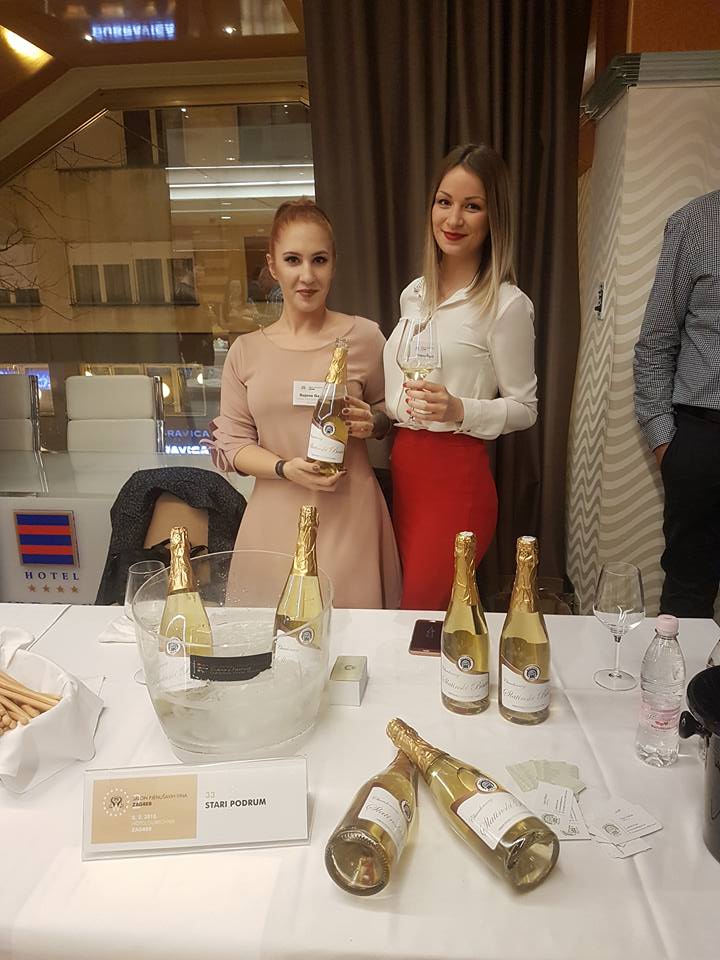 Slatina sparkling wine, revived by Ivan Halas at Stari Podrum, being presented at the 2nd Sparkling Wine Salon at the Hotel Dubrovnik in Zagreb © Tourist Board of Slatina
Slatina sparkling wine, revived by Ivan Halas at Stari Podrum, being presented at the 2nd Sparkling Wine Salon at the Hotel Dubrovnik in Zagreb © Tourist Board of Slatina
“As the Stari Podrum winery does not have adequate conditions for storing the found bottle, we took it to the Homeland Museum in Slatina where it will be stored,” Mr Halas told local news, upon the discovery of the bottle. “Only one bottle was found (so far), although there may be more. It is currently the only fully preserved one in the Slatina area. For now, we assume that it is from the period between 1864 and 1912 - we have no knowledge of the exact year, but the age of the bottle will be determined by experts.”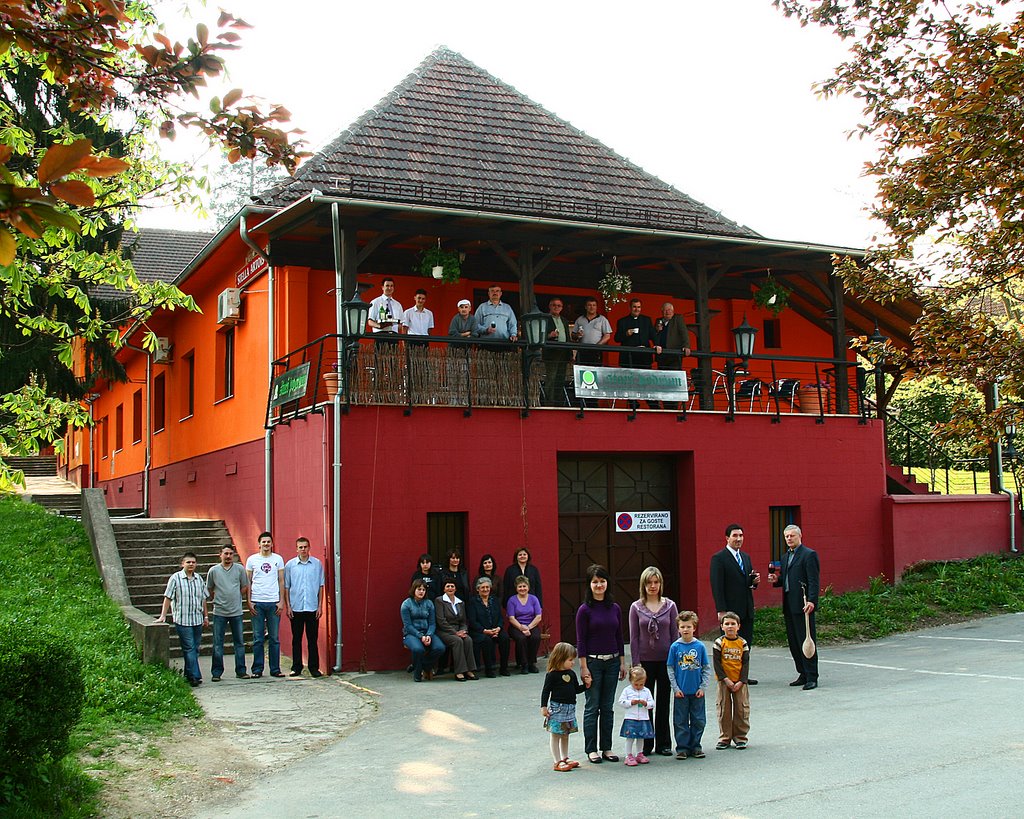 A more contemporary photo of the Stari Podrum enterprise in Slatina © Virovitica State Archives / Slatina Homeland Museum
A more contemporary photo of the Stari Podrum enterprise in Slatina © Virovitica State Archives / Slatina Homeland Museum
Croatia Wine: ”Every Visit Is A Voyage Of Discovery”
August 9, 2020 - Meet Marc Hough, a former international DJ who became a wine importer after visiting Dubrovnik and trying Croatia wine. In 2020, he returns for his 20th summer.
Situated in the north of England, about halfway up the island called Great Britain, the city of Manchester is famous for its football and music. Mancunians are proud of this. Two members of TCN are from the city, and when someone local asks “Odakle si?”, usually we say “Ja sam iz Manchestera” (I am from Manchester). We don't say "I'm from England" or "Great Britain". Everyone knows where Manchester is.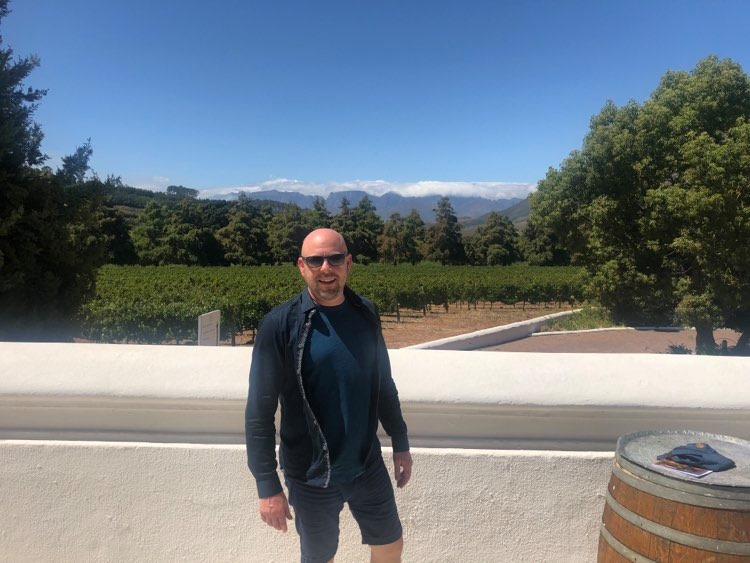
Marc Hough, a former international DJ. His passion for the Plavac he discovered in Dubrovnik turned him into a wine merchant.
20 years ago, Marc Hough was a high profile member of Manchester's famous music scene. He counts members of bands like The Stone Roses and The Happy Mondays as close personal friends. As longstanding DJ to New Order (the band that was once Joy Division), he toured the world playing the music of Manchester to many. But, no more.
“I reached the age of 40 in 2010 and thought, what am I doing with my life?” Hough told TCN over the phone, as he was preparing for a trip Dubrovnik. “DJing and the music business is a young man's game.”
And so, inspired by an enthusiasm for Croatia wine, he turned his back on a high profile DJ career and became a wine bar owner and wine merchant.
One of Marc's 'Cork Of The North' wine bars / stores near Manchester © Cork Of The North
“When I started, I was literally just selling wine out of the back of my car. I only had five customers and three of those were my dad, my brother and me!” remembers Marc, who has built his independent business considerably since then. He is now a wholesaler, recommending and selling wines to top bars and restaurants in the north of England. He has also opened two of his own wine bars 'Cork Of The North' (which are also wine shops), in Sale and Heaton Moor, near Manchester.
“Croatia plays such a big part in the story,” stresses Marc. “I've been visiting Dubrovnik for over 20 years. I had a friend from there who I met in Manchester. She came to live here for a while to escape the war. After it finished, she went home, invited me to Dubrovnik and I just fell in love with the place.”
“There was a wine bar in the Old Town called D'Vino, run by a half Croatian half Australian guy called Saša. After I saw what he was doing there with Croatia wine, I thought that's exactly the kind of place I'd like to have in Manchester.”
Already passionate about wine thanks to his grandad, that first trip to Dubrovnik made Marc curious to return. On his next visit to Croatia, he travelled further than just the Pearl of the Adriatic and went to the source of some Croatia wine itself.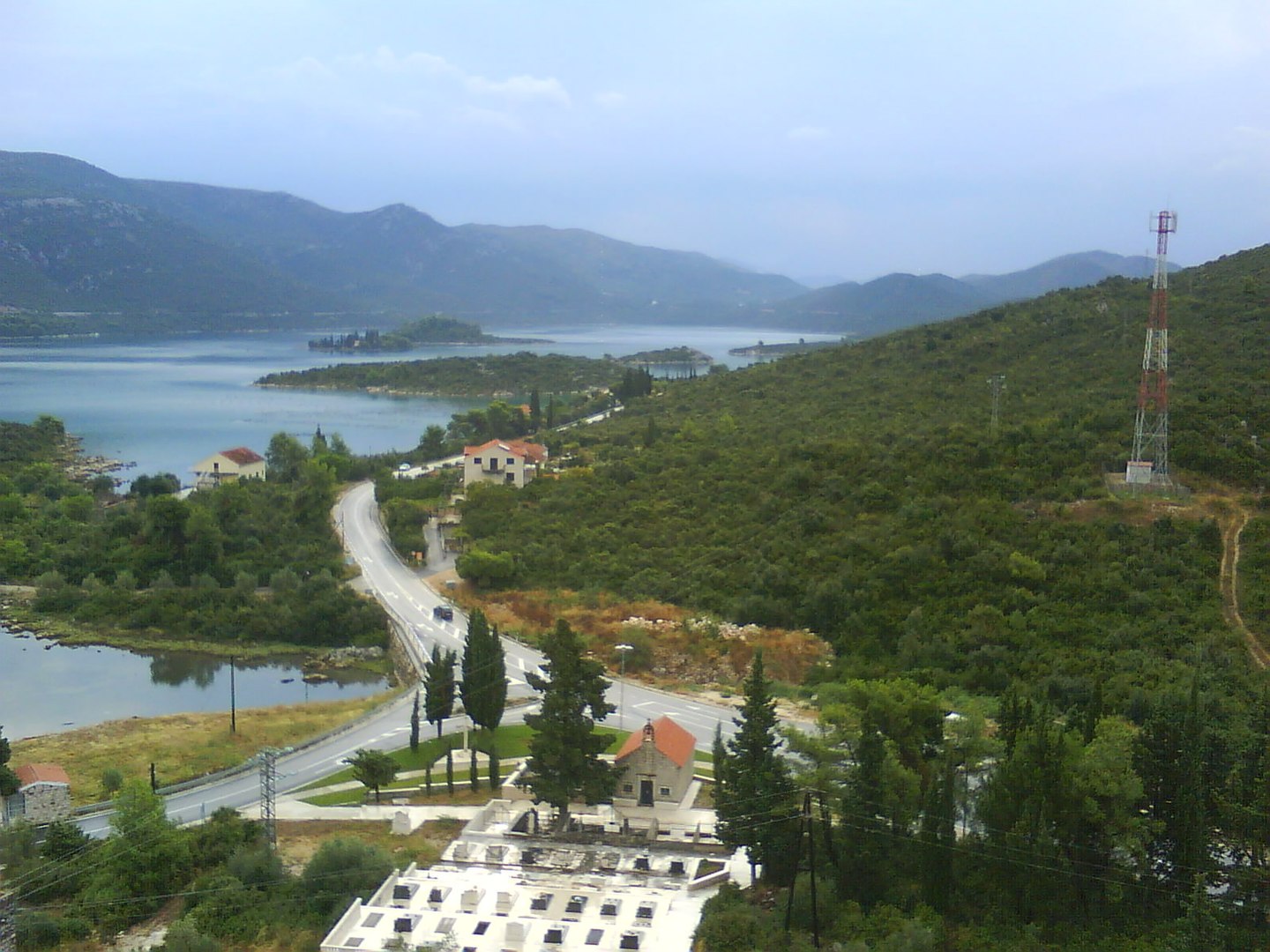
Part of the Pelješac peninsula, which features heavily in Marc's 20-year affair with Croatia wine © Anto
“I came back on a sailing holiday with Bernard Sumner (guitarist of Joy Divison and singer of New Order),” Marc recalls. “He loves sailing and he has his own boat. We went all round Pelješac, Korčula, Brač. I fell in love with Dingač. Since then, I've travelled all of Dalmatia and through Istria learning about the wines. I've been to Bosnia to try their varieties like Vranac. But, for me, the most recent, amazing discovery has been Slavonia. They make some incredible white wines there; Graševina, Cabernet Franc, Traminac.”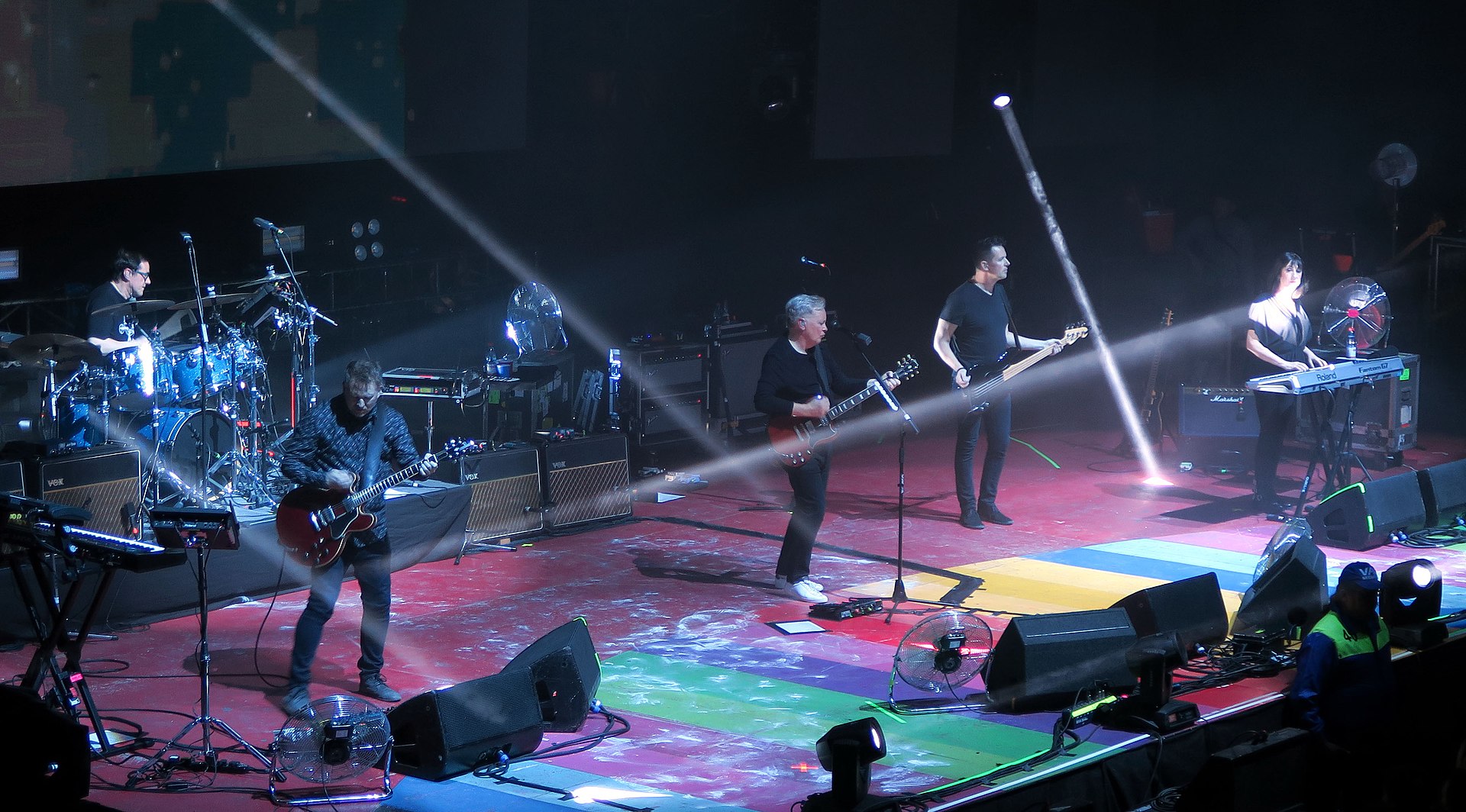
New Order, the band that was once Joy Division. Marc Hough toured the world as their DJ © RL GNZLZ
“For me, it's always half holiday, half work,” Marc tells us, as he packs for his 20th annual trip to Dubrovnik, which begins on Sunday 11 August. “Amazing views, amazing people, amazing food and amazing wine. But, the wine always inspires thoughts of work. I can't help myself. I love visiting the vineyards, meeting the winemakers. It's not the same as when you do it in other countries. In Croatia, you'll often be invited into the kitchen or onto the terrace of the winemaker's home. You'll leave with arms full of different bottles - some gifted - and you can even be sold fine wine unceremoniously in a plastic bottle. I love that informal, homemade feel of the experience. It's charming and honest. When I go on buying trips in France, Spain and Italy, it's rarely like that.”
Dubrovnik's tourist season has this year stalled in response to COVID-19. Its visitors' reliance on charter air and cruise ships has proved inflexible. Yet, a little further up the coast, in Makarska and Omiš, the city centres are now full of families who drive to these places every year. Dubrovnik's offer is more once-in-a-lifetime, less loyalty. Unless, of course, it's the wines and not the walls that call you to Dubrovnik.
“It's inevitable that I'll find something new that I want to bring back with me,” Marc says of his impending trip. “Every visit is a voyage of discovery. This time, although I'll again be based around Dubrovnik, I'm determined to go to Slavonia to look at some Graševina and Cabernet Franc, which thrives in the terroir there.”
Marc Hough with just one of his famous friends from the Manchester music scene. Bez, of the band Happy Mondays, is now a customer at Cork Of The North © Cork Of The North
“I wanted to start importing Croatia wines years ago but, for someone at my level, it was so difficult before Croatia became a full member of the EU. Tariffs were payable on the borders and if you wanted to move wines from south Dalmatia - Dubrovnik and the islands - you'd have to go through the border with Bosnia. I lost several whole shipments to the Bosnian police, who said my paperwork was incorrect (it wasn't). It's much better these days. But, there's still very little Croatian wine in the UK, even though the interest in Croatia wine is massive. There's a big demand from people who are really passionate about wine, but also people who come back from holiday, have enjoyed Croatian wine, go searching for it, and just can't find it.”
Cork Of The North varies its selection of fine wines throughout the year. At the moment, Marc stocks Kozlović Teran and Kozlović Malvasia from Istria and Septem Pontes Plavac Mali from Pelješac.
“For an independent like me, I buy an export pallet for each wine I want to bring back. That's 600 bottles of each wine.,” he says, “and as my own personal passion right now is for Graševina, I expect at least one of those to be filled with Slavonian wine on this trip.”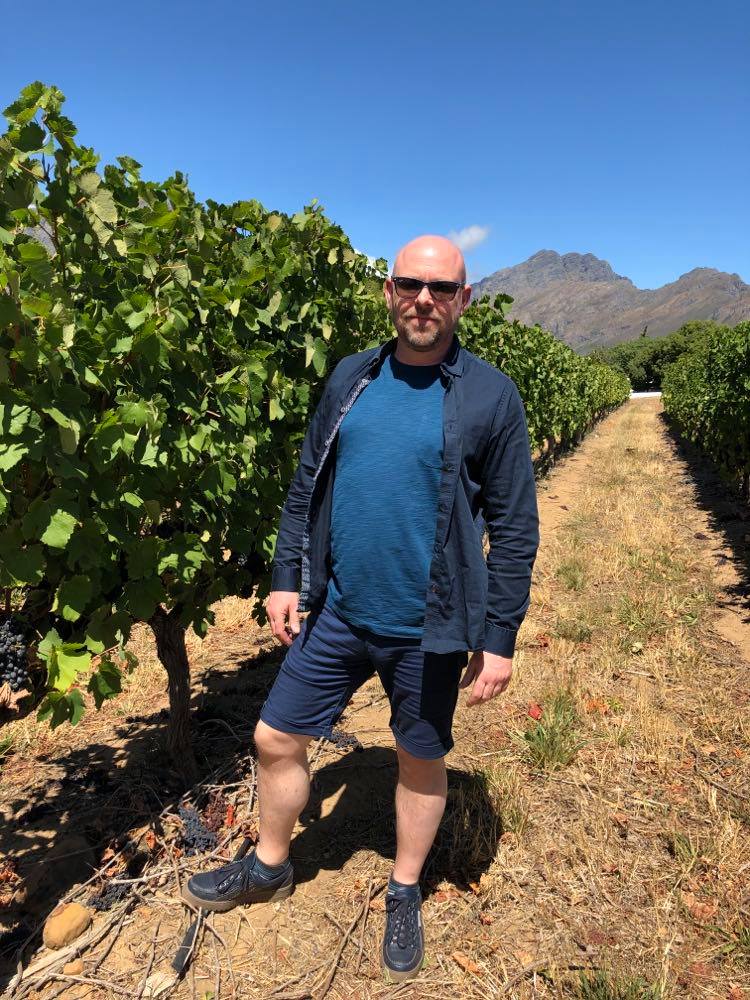
Marc Hough on one of his Croatia wine buying excursions
Visit Osijek on the Croatian Road Less Travelled
July 8, 2020 - TCN travel series The Croatian Road Less Travelled with Marc Rowlands. In this edition, we visit Osijek in eastern Croatia, on the banks of the Drava river and look at things to do in Osijek
Situated in the far east of Croatia, the city of Osijek is a sizeable distance from the regular coastal or capital city footfall of visiting tourists. Indeed, considering its history, importance and its vast, unique appeal, its surprising just how many Croatians you meet who have also never been to Osijek. Sitting on the banks of the Drava river, the city is the de facto capital of Slavonia and the administrative centre for Osijek-Baranja county and served as a strategically important outpost in the Roman, Ottoman and Austro-Hungarian empires. Osijek was the first city in Croatia to have a tramway and, after Rijeka, the first Croatian city to be serviced by an international train route (running to Pécs in Hungary via Beli Manastir, this very line was re-opened in 2018).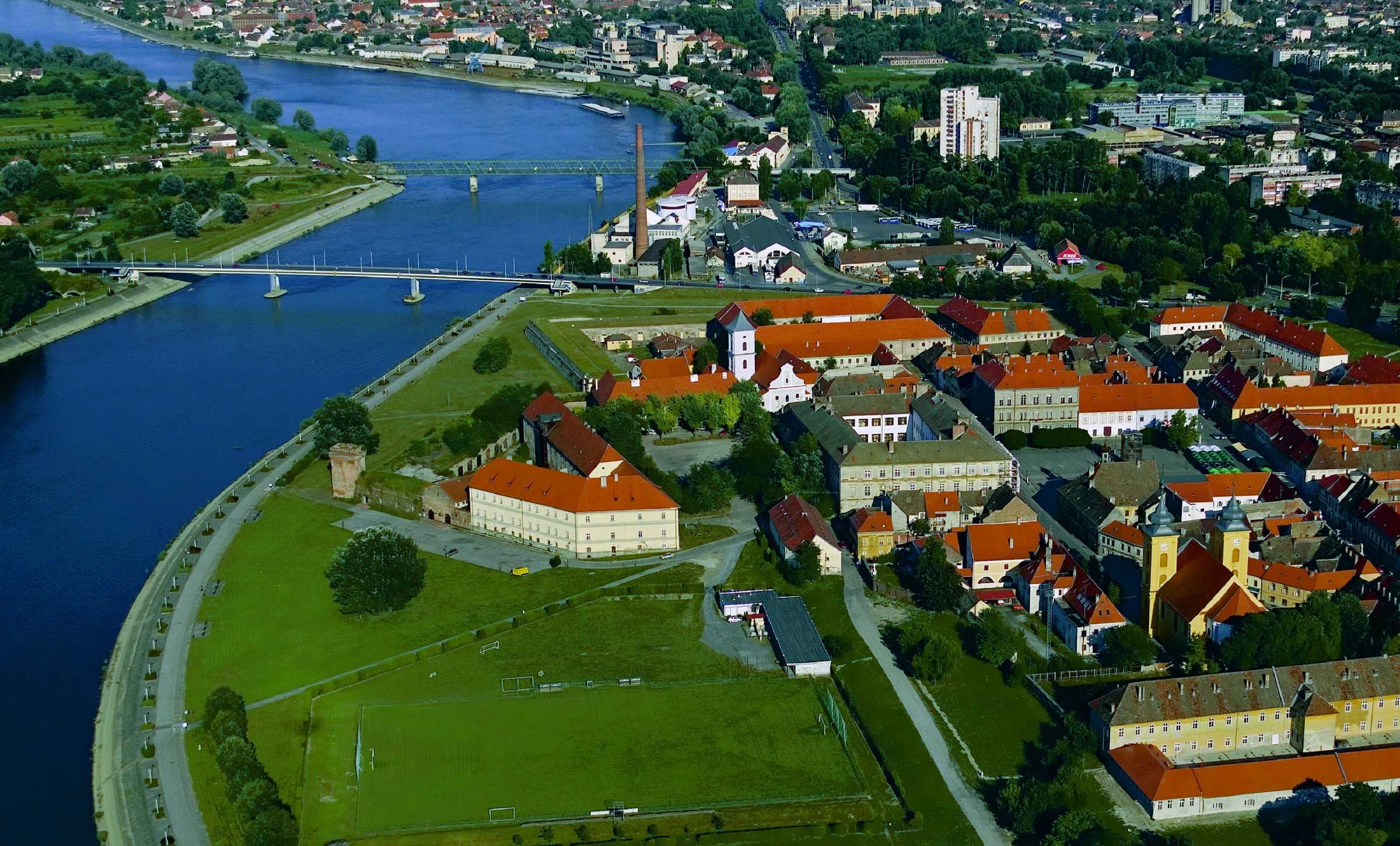
Osijek's Old Town, Tvrđa, is the largest and best-preserved ensemble of Baroque buildings in Croatia. It sits spectacularly by the Drava river, separated by the defensive walls of its Hapsburg-era fort © Romulić & Stojčić
Why visit Osijek?
Osijek is an incredibly beautiful place and perhaps Croatia's only option which simultaneously offers all the thrills of a genuine city coupled with incredible nature. It's possible to walk from one end of the city to the other passing only through statue-littered parks, the air is constantly fresh and, being Slavonia, the ground is entirely flat, making it a great place for bicycle enthusiasts. It's also a great place for swimming and other water activities such as fishing, rowing and boating. Osijek has a range of great nightlife options; three catering to fans of turbo-folk, two for those who prefer tamburica and Croatian folk music, one for students, one for the alternative crowd and several bars which host live music including jazz. Specialist monthly club nights offer drum n' bass, hip hop, house music and the techno night, Traum, is well known across Croatia and fronted by two of the country's finest DJs in the genre - Insolate and Volster.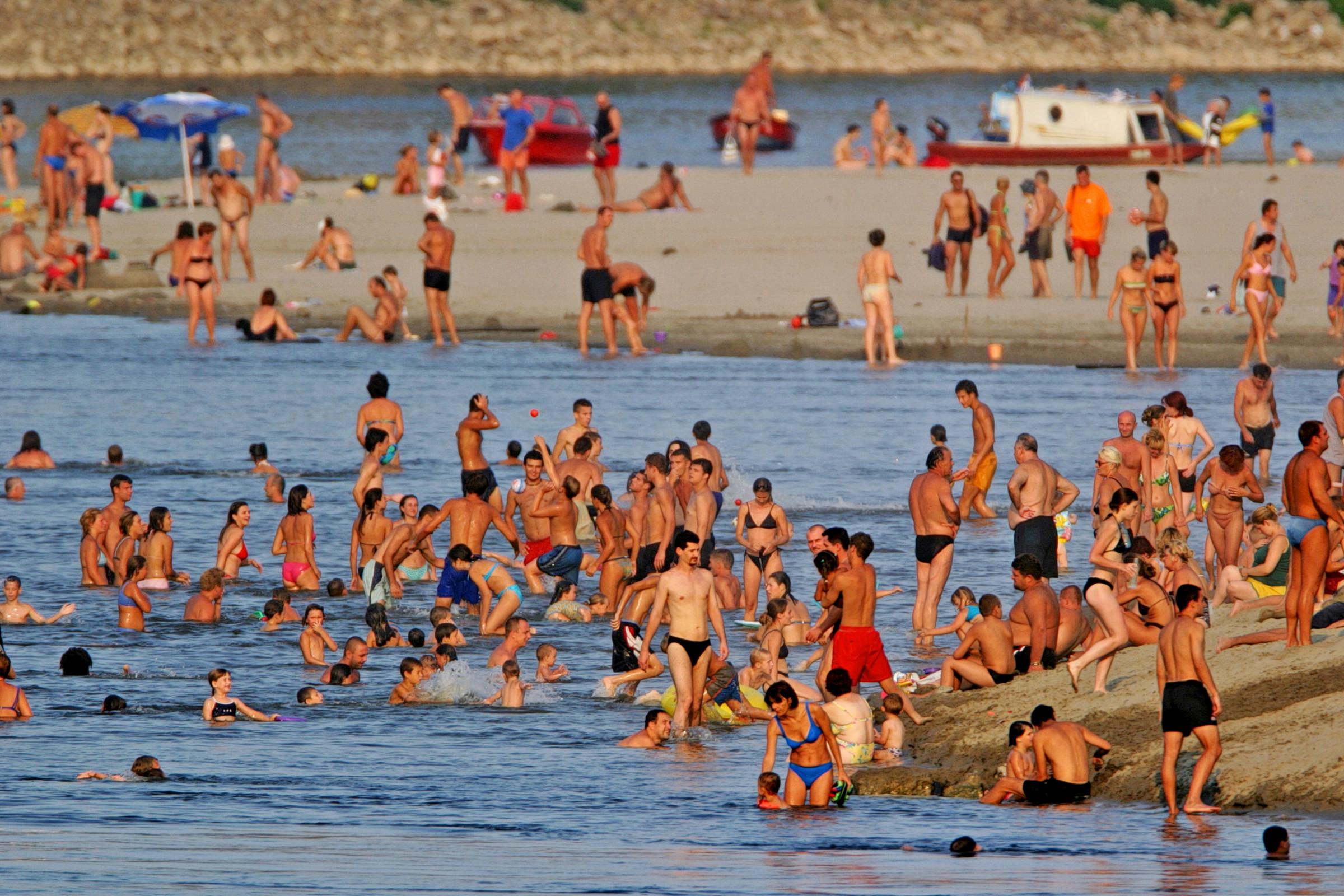
Cooling off in the Drava river, right in the heart of the city - just one of Osijek's great swimming options © Romulić & Stojčić
Osijek has, by far, the longest waterfront promenade in Croatia. Both banks of the Drava are pedestrianised. On the side of the city, the prom is lined with parks, cafes, bars and restaurants built within converted river-cruising boats. This side also holds the impressive Osijek city walls, behind which lies the Old Town centre, Tvrđa. On the opposite banks, you'll be walking alongside wild nature, with the vast open-air swimming complex Copacabana at one end and Osijek Zoo at the other. Osijek's pedestrianised bridge links both sides in the middle; it's is one of the city's most iconic sights and looks particularly special at night when colourfully lit.
Osijek pedestrian bridge by night © Romulić & Stojčić
Osijek and wider Slavonia are Croatia's least-heralded gastronomic powerhouses. The cuisine here is as unforgettable as the warm Slavonian welcome. Paprika-rich stews such as čobanac (made with locally caught wild boar and deer), fish paprikaš and perklet are a clear influence of nearby Hungary and most attempts to faithfully reproduce them outside the region fall extremely short. Although all you'll ever hear about is pršut from Dalmatia and Istria, Slavonians are masters of curing pork and even have their own high-quality breed, Slavonian black. Authentic kulen from Baranja is unquestionably the highest quality sausage from Croatia and you'd have to look hard to top Slavonia's paprika or garlic-flavoured kobasice too. In Osijek, as in its wider region, you can go to a restaurant and order one of the best pizzas you'll ever try and pay the same as you would for a starter course on the coast. 
A selection of Slavonian meats. Kulen is a speciality of Slavonia and Baranja, the best quality sausage made in Croatia. It is preserved, made from top cuts of pork, richly red from paprika and versions from both Slavonia and Baranja are protected at an EU level. You can spot the one from Baranja by its irregular shape © Romulić & Stojčić
If you're a fishing or hunting enthusiast, this is also the place for you – days floating down the Drava along the 15 kilometre stretch before its confluence with the Danube can be as unforgettable as the monster-sized fish you can catch here. Osijek also makes a great permanent base for travel in the wider region, with trips across the nearby Serbian and Hungarian border offering different cuisines and culture again. The Slavonian white wine industry can also be explored from here. Equidistant between Zagreb, Budapest and Zagreb international airports, it's conveniently placed on the intrepid backpacker's route too.
Rowing on the Drava river in Osijek. The city has produced several champions in the sport © Romulić & Stojčić
How to get to Osijek
Osijek has its own airport. With established internal and international routes, this holds huge potential for the city. However, it is not without its problems. That no public transport service runs between the airport and the city is shameful. Unless you know a local, your only option is a taxi, whose fixed rates are substantially higher than the 25 kuna maximum it will cost you to travel between any two points in the city itself. Conflict between budget airlines and authorities has resulted in some international routes being cancelled. Bargaining budget airlines demand lower landing fees in return for the tourists they can deliver into the local economy. But, largely, those using the routes are not tourists; they are locals from Croatia, Hungary, Bosnia and, in particular, Serbs from Vojvodina, for whom Osijek is the most convenient airport to fly to on their way back from work in Germany or Ireland. Why should Osijek subsidise their travel? One solution may be to implement a passenger landing fee which can be fully recouped by tourists via vouchers for any accommodation they take in the city or wider Slavonia.
Osijek train station, one way to arrive when you visit Osijek © Romulić & Stojčić
Osijek is well connected by bus; you can travel there from Belgrade and Novi Sad in Serbia, from Zagreb, direct from coastal regions Istria, Kvarner and Dalmatia and even from Montenegro, via Dubrovnik and Imotski. It is accessible by train from all of northern Croatia and Zagreb although the lines and stock have not been updated in so long that, shamefully, it's actually quicker to take the fast train from Zagreb to Vinkovci, disembark and take a local bus to Osijek than it is to travel on the direct train there from the Croatian capital.
Where to eat: Slavonska Kuća, Kod Ruže, Vrata Baranje or Čarda kod Baranjca are brilliant, informal places to try traditional Slavonian cuisine, including all dishes mentioned previously. Further out of the city, Ugostiteljski Obrt Varga in Bilje, Citadela and Darócz in Vardarac and Didin Konak in Kopačevo are really special versions of the same. Rustika is the best sit-down pizza restaurant in the city, has a lovely summer courtyard for dining and is extremely affordable.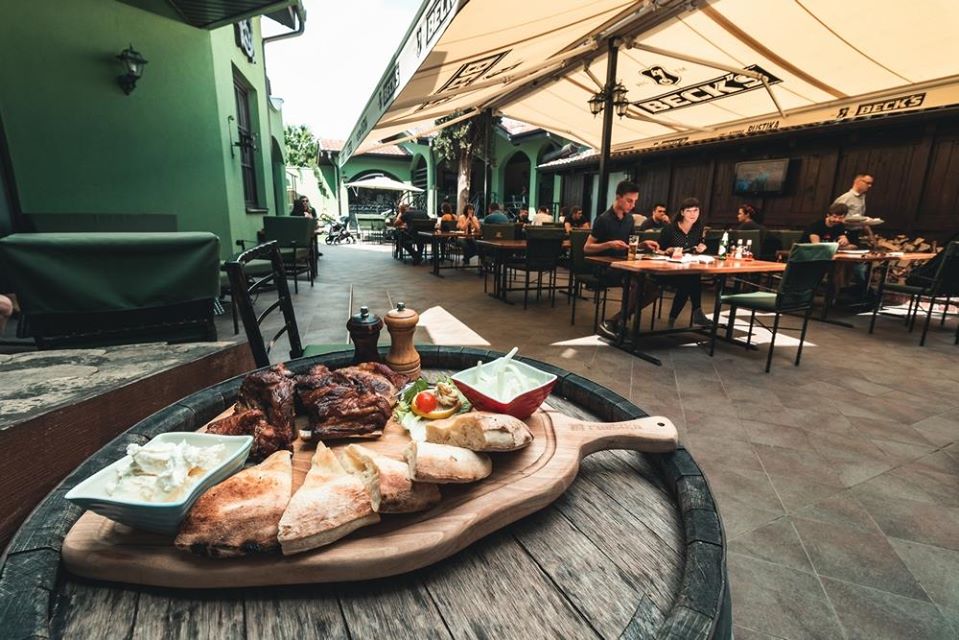
The courtyard at Rustika, a great, casual place to dine and try Slavonska pizza when you visit Osijek © Grill pizzeria Rustika
Food to go / home delivery: Lipov Hlad and Pizzeria Novi Saloon do the best home delivery pizza in the city (Rustika deliver too). Other choices are thin on the ground, save for the standard fast-food chains and pekara (the El Pan bakery on the edge of Sjenjak hood does the best burek with meat).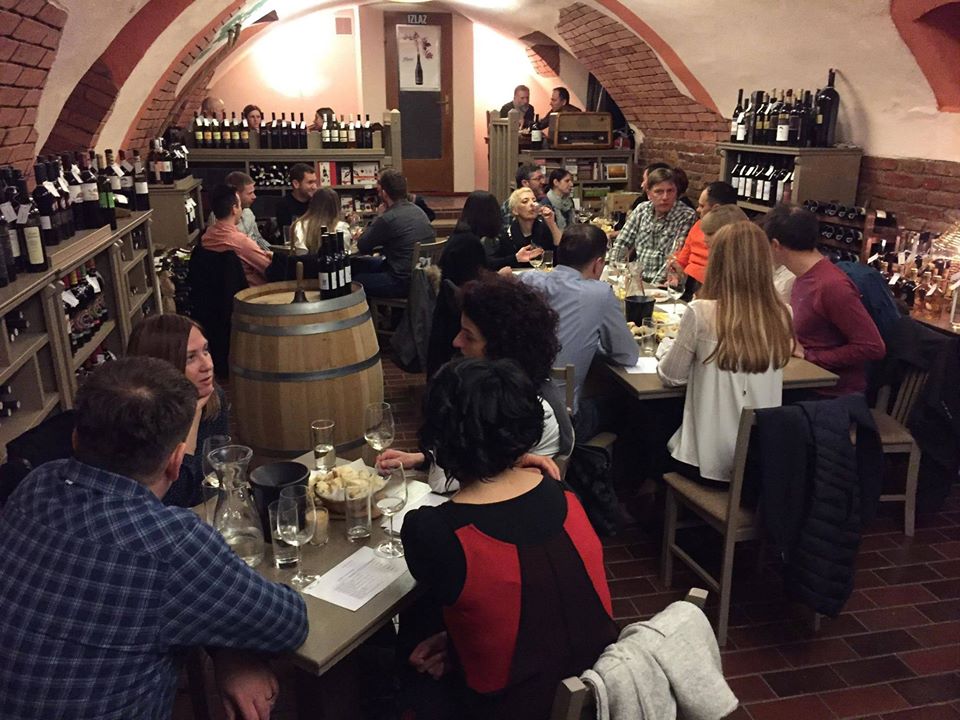
Get to know Slavonian wine when you visit Osijek © Vinoteka Vinita
Where to drink: The simple but extremely passionate Vinoteka Vinita is one of the best places to try Slavonian and Croatian wines, with many top and rarer titles sold by the glass. If you're more into beer, Beertija in the modern city centre has a great range. General Von Beckers on Tvrđa is the best place to try the leading local craft ale, Beckers, but all of the bars on Tvrđa are worth investigating and during the summer their terraces stretch far into the historic square creating a unique atmosphere.
What's new? Osijek's football club is undergoing a renaissance following its purchase by new investors. An impressive new stadium is reaching completion and you shouldn't be surprised to see this team challenging for the top domestic titles, or reaching European competitions, in the near future.
Fiš paprikaš is a Slavonian speciality. Spicy from paprika, it is made from river fish and can often be seen being cooked in a large pot over a blazing open fire if you visit Osijek in warmer months © Romulić & Stojčić
What not to miss: The protected nature park Kopački rit is wonderful to visit at any time of year, a sanctuary for all manner of wildlife, particularly rare species of birds. On Tvrđa, Slama Land Art hosts workshops, art and music events and you'll meet great creative types there. There's an extreme sports event, Pannonian Challenge, which sees international competitors visit Osijek and an annual Osijek Beer Festival which feels more like a street party. There's also a music festival called UFO. Osijek Wine Days and the celebrations celebrating the end of term at the city's sizeable university are each year accompanied by great partying and music performances. Look up the art deco Cinema Urania. At over 100 years old, it's Croatia's best independent cinema outside Zagreb. If you're looking for something a little more upmarket than the aforementioned Copacabana outdoor pools, or if you're visiting in cooler months, the renowned Bizovac Toplice is close by and there are free bus shuttle services from the city. It's a sprawling spa complex with multiple pools, offering fun and wellness therapies. But, whatever you do, don't miss the extraordinary and varied architecture of Tvrđa or Slavonian cuisine.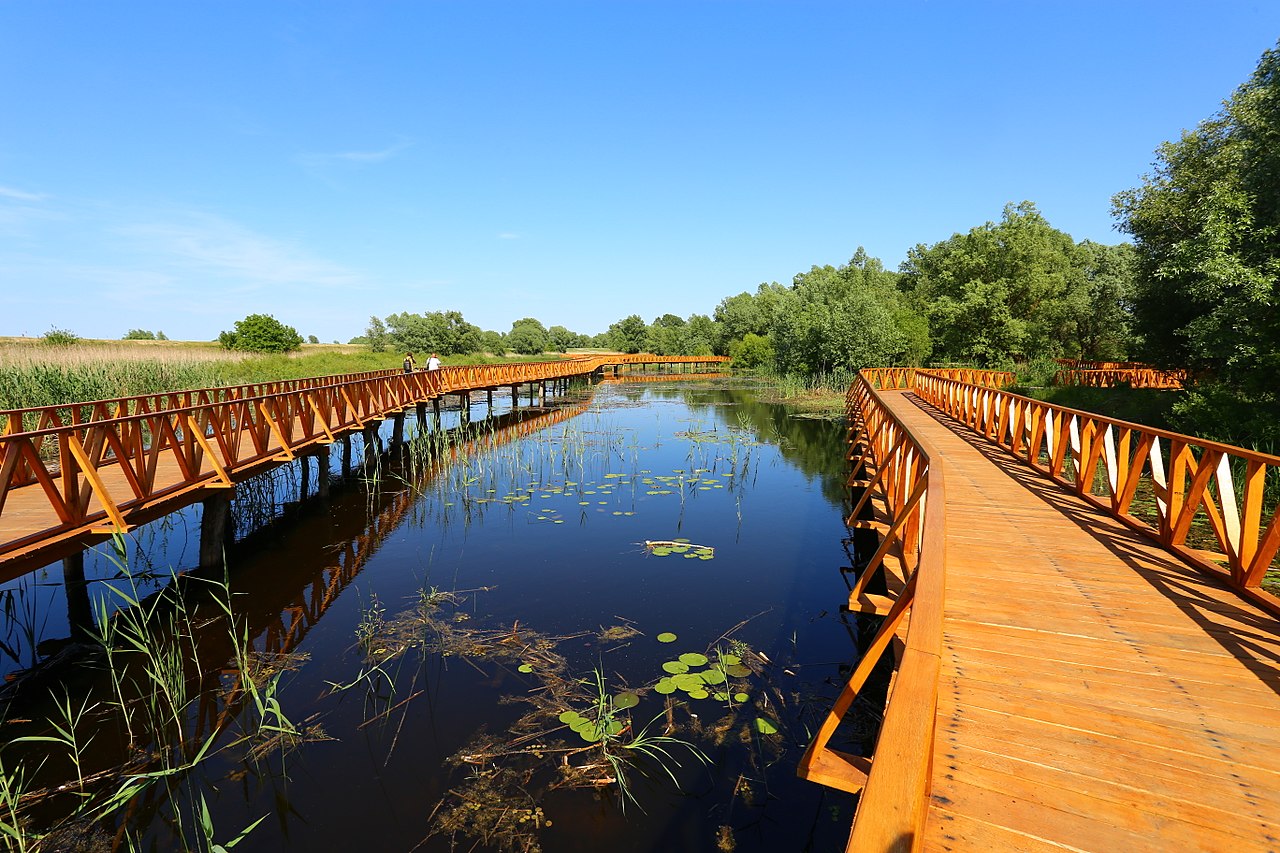
Kopački rit. The nature reserve is a must all year round when you visit Osijek © Misalalic
What to buy: If you're heading somewhere else in Croatia after you visit Osijek, take some Baranja kulen with you for posh sandwiches. Slavonia is famous for its honey, which is protected at an EU level. Take some back home with you. Local designers Lega Lega make cool t-shirts and accessories emblazoned with words exclusively used in the local dialect. Pick up some Slavonian white wine when you visit Osijek. Graševina is the most commonly made white wine in Croatia and the most popular. They make the best Graševina in Slavonia, but also look out for Chardonnay, Pinot Blanc, Pinot Gris, Sauvignon Blanc and Traminac too. There are countless excellent wine producers in Slavonia to look out for, including Kutjevo Graševina, Krauthaker, Galić, Trs, Adžić, Kolar, Enjingi, Antunović, Erdut and Iločki Podrumi.
'Lega' in local dialect is short for colleague. It is a term affectionately (and exclusively) used when speaking to someone from Osijek. Try using it when you visit Osijek © Lega-Lega
On these links you can read about the other destinations in our The Croatian Road Less Travelled series:
Ludbreg - a site of Holy pilgrimage where the historic meets the contemporary
Donji Miholjac - a hidden gem in the heart of the Pannonian basin
For the latest travel info, bookmark our main travel info article, which is updated daily.
Read the Croatian Travel Update in your language - now available in 24 languages
Join the Total Croatia Travel INFO Viber community.
Croatian Wine Regions: Slavonia & Danube
January 8, 2019 — In the fourth and final article of the Croatian Wine Regions series, TCN unveils Slavonia and the Danube plains, the country's largest winemaking region.
The easternmost Croatian winemaking region is first and foremost characterized by the three rivers that enclose it: the Danube, Drava, and Sava. The closeness of these three rivers creates a special microclimate which is especially favorable for the cultivation of Graševina; the region's no.1 white variety.
Slavonia's darling, Graševina is in Germany known as Welschriesling, and its closest relative is said to be Elbling, though this white variety supposedly originated in northern Italy, where it is known as Riesling Italico. In Croatia, however, Graševina spreads on more than 8,000 hectares of vineyards, from the city of Daruvar, through the famous Zlatna dolina (lit. Golden Valley) around Kutjevo to the far east of Baranja, Ilok, and Srijem. However, it is often said that the finest Graševina comes from the sun-drenched vineyards of Kutjevo which is nestled in the very heart of Slavonia, in a valley surrounded by a low mountain range.
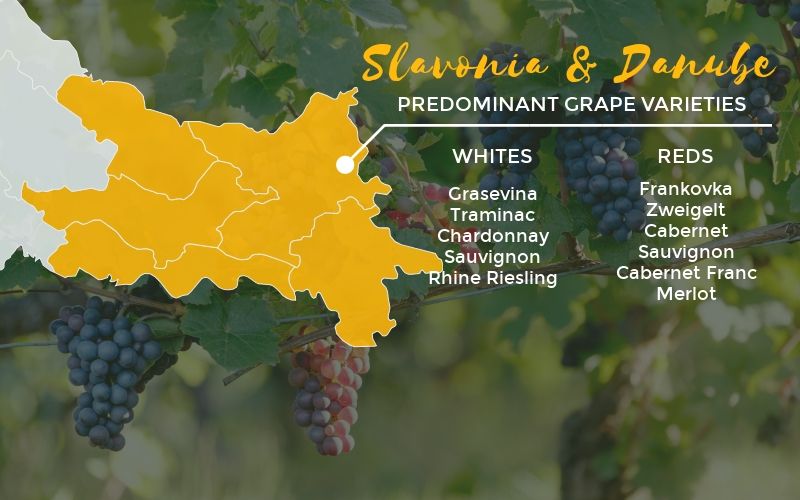
Depending on the terroir, Graševina wines can range from the delicate, refreshing styles found in western Slavonia to quite opulent, dry, fresh and mineral styles from central Slavonia, to mature, robust, full-bodied Graševina wines hailing from the Danube plains.
In addition to Graševina, the area around the eastern border of this region is also championing Chardonnay, Traminac (aka Gewürtztraminer), Rajnski Rizling (aka Rhine Riesling), and Sauvignon. As for the reds, Slavonia is mostly home to Frankovka (aka Blaufränkisch) and Zweigelt, but also Cabernet Sauvignon, Cabernet Franc, and Merlot.
Slavonia has a cold continental climate, so as a general rule, the vineyards in this region are dominated by white varieties that produce dry, fresh and aromatic wines. Also, the region is becoming recognized for its sweet icewines that can age for decades and are regarded as jewels of this region.
And apart from its wines, Slavonia is also known for the world-famous Slavonian oak which is used for making wine-aging barrels not just in Croatia but also in neighboring Italy.
Stay tuned for more related topics by following TCN's dedicated gourmet page.


